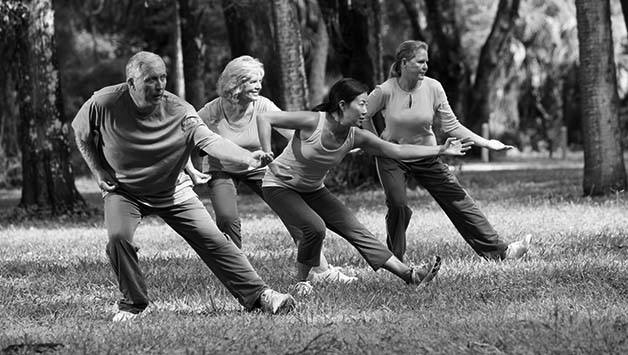
Did you know that falls are the leading cause of all injuries among older Americans? More than 25% of people aged 65 and older fall every year, resulting in more than 3 million emergency room visits and 800,000 hospitalizations. These injuries leave many with financial burdens and have devastating impacts on their physical and emotional well-being.
Prevention programs, such as balance training, can help you lessen the threat of falling. If you’re over 50, or even approaching it, now is a great time to empower yourself. We made a free guide you can download to help you track your progress.
While you may believe your risk of falling at age 50 is low, a study finds it’s actually the time your balance may start to decline. More specifically, without prevention measures, midlife is when your ability to stand on one foot begins to diminish. People in their 30s and 40s are generally able to stand on one foot at least 1 minute. That time drops to 45 seconds at age 50; 28 seconds at 70; and 12 seconds at 80, showing a gradual, yet dramatic decline in our balance with age.
If you suffer from problems with sleep, you also increase your risk of falling. Another factor affecting your balance is sarcopenia — or the loss of muscle mass that occurs with age. While strength training can combat this and has positive effects on balance, you may want to start by focusing on balance if you’re new to exercise.
Before you start, remember, some factors outside of age affect balance. These include inner ear issues, nerve damage, neurological conditions, or medications. In these cases and others, it’s important to speak with your doctor before beginning any exercise program. Your physician may offer guidance on the best balance exercises for your condition.
Balance exercises for seniors can help you stay upright and maintain your mobility. Because most balance exercises are low impact, you can do them as many days per week that you want. The best exercises are those that target the parts of your body that help you stay balanced — from your core down. Working on all these areas requires you to do multiple exercises.
Balance training can be accomplished in group classes:
Tai chi
Originally an ancient Chinese martial art, tai chi is a gentle practice focused on movement and proven to strengthen your upper and lower body. Studies show that practicing tai chi reduces not only your risk of falling but also the fear of falling.
Water aerobics
Aquatic exercises, or water aerobics, can strengthen muscles and increase flexibility in seniors while also improving balance. Water provides a safe and supportive space to do so.
Yoga
Like the other types of classes, yoga can benefit you in multiple ways — strengthening muscles in your core and legs while enhancing your balance and flexibility. Some yoga classes incorporate the use of chairs for stability and peace of mind as you get started. If you’re unable to get to a class, no need to worry. Several YouTube channels are devoted to yoga workouts.
If you prefer to perform balance exercises in the comfort of your home, you can start with:
Place your hand on a tabletop or the back of a heavy chair. Standing tall, bend one knee to lift one foot back into the air. Hold for 10 seconds, if you feel steady on your planted foot. Then switch to the other foot. Repeat each foot 10–15 times, if possible.
Find a foot stool or set of stairs. You may also want to have a chair or tabletop nearby to hold onto for balance. With your shoulders back, tap one foot onto the step and then move it back to position. Repeat this movement, tapping the same foot, 15–20 times before moving on to the next foot.
Be near a wall or the back of a couch to steady yourself, if needed. With your shoulders back and core tight, place the heel of one foot in front of the other foot. Then, walk forward, putting the other heel in front of the other foot. Continue this until you reach the end of the wall or couch, and repeat.
Once you feel comfortable doing these balance exercises, you can build on your efforts by no longer holding onto surfaces. You can also increase the number of repetitions or search online for other balancing exercises to add to your routine.
Download the free guide "4 types of exercises that are important over 50" >
Photo credit: iStock
Wellabe offers life and supplemental health insurance plans to help you prepare for good days and bad. We’ll always be here to empower you to be well — well prepared, well protected, and well loved.